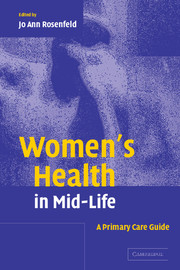Book contents
- Frontmatter
- Contents
- List of contributors
- 1 Introduction
- Part I Health promotion
- 2 Physical activity and exercise
- 3 Nutrition
- 4 Psychosocial health promotion of mid-life women
- 5 Sexual health
- 6 Alcoholism, nicotine dependence, and drug abuse
- 7 Depression and anxiety
- Part II Hormonal changes
- Part III Disease prevention
- Part IV Cancer prevention
- Index
- References
4 - Psychosocial health promotion of mid-life women
from Part I - Health promotion
Published online by Cambridge University Press: 21 August 2009
- Frontmatter
- Contents
- List of contributors
- 1 Introduction
- Part I Health promotion
- 2 Physical activity and exercise
- 3 Nutrition
- 4 Psychosocial health promotion of mid-life women
- 5 Sexual health
- 6 Alcoholism, nicotine dependence, and drug abuse
- 7 Depression and anxiety
- Part II Hormonal changes
- Part III Disease prevention
- Part IV Cancer prevention
- Index
- References
Summary
Introduction
The promotion of health in women during the mid-life years requires a knowledge base beyond the traditional biomedical one. This base extends considerably the boundaries with which many primary care providers are familiar, moving into psychological, economic, sociologic, and political realms. A context for understanding the psychosocial issues that may enhance or detract from the quality of a given woman's life is critical to the respectful and thoughtful care that best serves the woman in need. Appreciation of the developmental issues facing mid-life woman as they age and their particular relational context is critical to the provision of good medical care.
No woman's psychosocial health can be assessed or promoted in a vacuum. Gender expectations, socialization, caring, multiple roles, economic demands, perceived and actual supports, and ethnicity and race impact healthy functioning. Experienced providers appreciate the power of these issues on the perception and experience of wellbeing and recognize that time and attention paid to these matters is not wasted. Indeed, the relational work of provider–patient can itself be a powerful tool in the cause of health promotion.
A dilemma confronts the practitioner committed to evidenced-based medicine in the arena of psychosocial health and change. Unfortunately, there is no “evidence base” for such complex, intertwined issues of culture, race, class, identity, socialization, and gender roles, and their intersection with social, economic, and political realities.
- Type
- Chapter
- Information
- Women's Health in Mid-LifeA Primary Care Guide, pp. 45 - 60Publisher: Cambridge University PressPrint publication year: 2004

